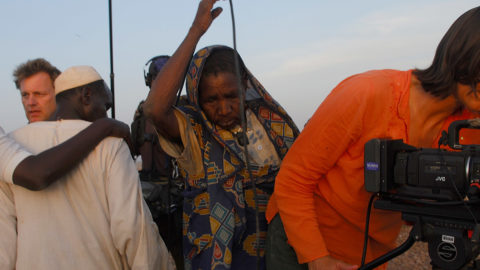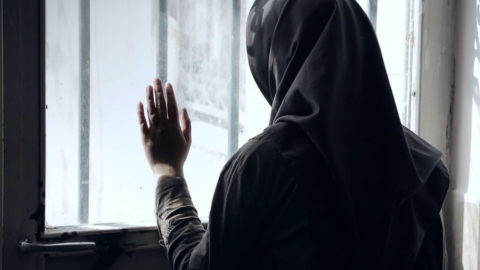By Michael Koresky in the September-October 2016 Issue
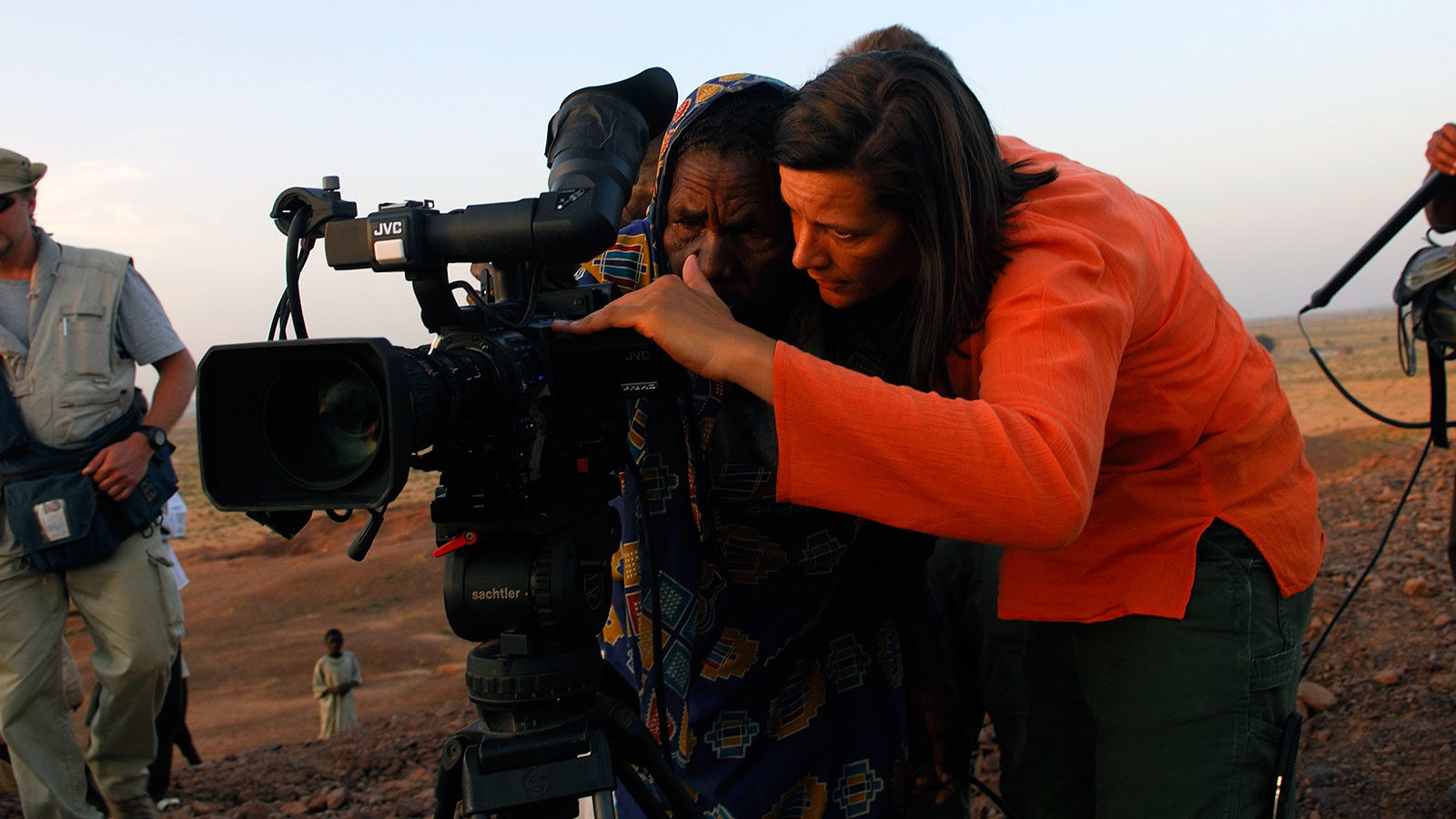
I Am a Camera
Cinematographer Kirsten Johnson harnesses her life’s work to define a filmmaking philosophy in Cameraperson
Film practitioners have long tried to describe the abstract power of their practical tools. Director and critic Alexandre Astruc famously called the movie camera a caméra-stylo, or camera-pen; likewise Agnès Varda coined the term cinécriture to describe her style, the sense of a film being written by the camera. And even earlier, British documentarian Basil Wright—colleague of nonfiction trailblazers John Grierson and Humphrey Jennings—wrote: “What is fundamentally important is to realize that where the camera is put must depend, not on an attempt to make the shot ‘striking’ or ‘interesting’ at all costs, but on the urgency of expression affecting the man behind the camera.”
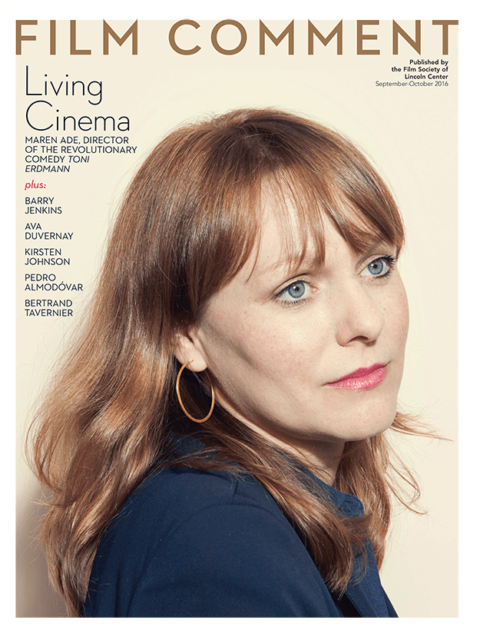
From the September-October 2016 Issue
Also in this issue
This statement is found in a functional, almost instructional essay titled “Handling the Camera,” from a wonderfully stuffy 1937 collection of writings for burgeoning cinephiles called Footnotes to the Film. Today, even more notable than the gender rigidity of this passage is its acknowledgment—in this first full decade of sound cinema—of the camera as an extension, almost an appendage, of the person looking through it. But then there’s also this: “It is an object to be polished and cleaned continuously, to be transported with the care lavished on a newborn baby, to be guarded jealously against the hands of the incompetent and the careless, the destroyers of delicate machines.” Here, Wright makes the camera precious by making it a fragile, delicate child—therefore human. The camera is not just a tool, it speaks for us, it writes for us, and it’s also part of us.
Cinematographer Kirsten Johnson continues the ongoing interrogation of the power of the camera in her new film, Cameraperson. A labor of love of the highest order, it is culled from decades of footage Johnson shot for a variety of directors on more than 25 films around the world. Because it doesn’t have narration or any sense of linear chronology, the film could at first be considered “stream of consciousness,” though it becomes clearer as it continues—and even more so on subsequent viewings—that the various scenes have been woven into a meticulously planned work of philosophical inquiry. It’s discursive rather than diaristic; the footage has been brought together so that viewers can muse upon the potentially endless ways the camera can be used—how it can express an idea or reflect an ideology; how it intrudes or ignores, and how either can be devastating; how it can lie by trying to tell the truth, and how it can come upon the truth by lying; how it reveals all for the world to see, and how it keeps secrets only for itself; how it engenders empathy or fear; how it changes landscapes or simply bears witness. Simply put, these are the mysteries of cinema, which are made more mysterious and acute in the realm of nonfiction, where there’s an implicit contract between audience and filmmaker that what is on the screen is somehow a truth or some variation on the truth. Johnson’s extraordinary film expresses the tensions and exhilarations around these issues through the actual physical viewpoint of the person for whom constantly reconciling them is part of her trade.
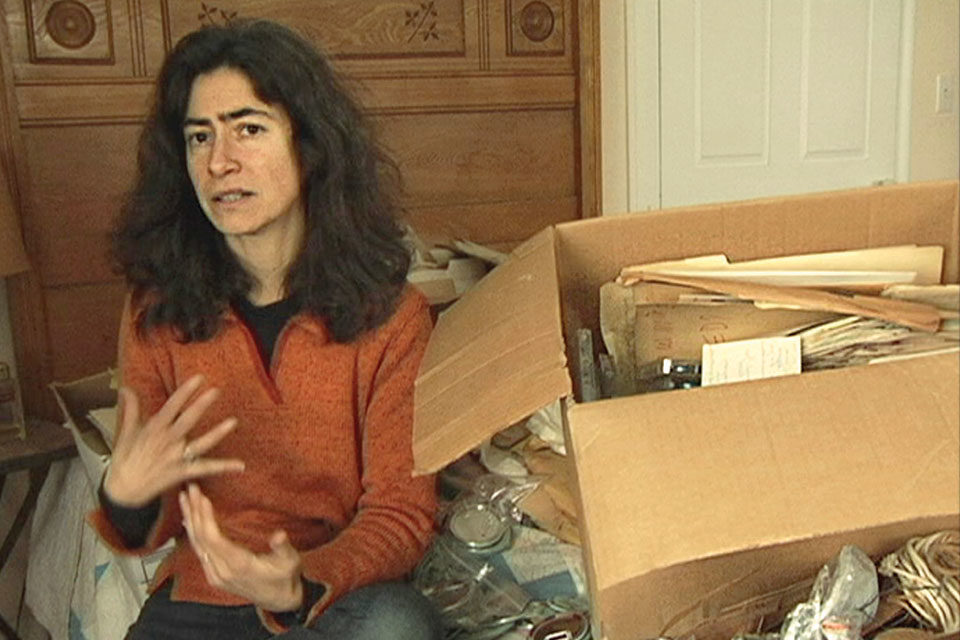
What’s most remarkable is how lucidly these ideas and issues are conveyed strictly through images. We never are told during Cameraperson the titles or context of the individual films she was working on when the footage was originally shot; the only information we receive are text cards telling us the name of the city we’re suddenly in with each cut to black. We see Johnson on screen only once, near the end of the film, in a surprising and highly personal reveal; otherwise she is an unseen presence, patient yet never absent.
The myth of the objective documentary filmmaker—that nonfiction works are inherently fly-on-the-wall portraits in which the camera just happens upon something compelling—is dashed right in the opening, when we move quickly from Foca, Bosnia, which will prove to be the film’s main anchor point, to Nodaway County, Missouri. In both places, we hear a voice from off screen, presumably Johnson’s. In Foca, the camera searches rural environs; the voice comments on the patches of wildflowers; a shepherd and his flock trail by. When she finds the right composition, a hand emerges from the left, reaches around to the front of the camera and pulls a few blades of grass from the ground, so they’ll sully the frame no longer. In Missouri, we also see a landscape shot, of a highway in late afternoon, a storm brewing in the gray sky. Chain lightning strikes on the horizon, eliciting a little gasp of pleasure from behind the camera. A thunderclap. It’s a perfect shot, in a sense. And then—a sneeze, jostling the frame into spasms. The message of these two opening shots is so basic as to be brilliant: there’s someone behind the camera, living, breathing, sneezing, thinking. There is no true objectivity, not just here, but in all film. Every shot is the result of a choice.
Of course, André Bazin was right, as he always was, when he wrote in 1947 about Jean Painlevé’s shimmering “science films,” documentary shorts shot mostly underwater: “The camera alone possesses the secret key to this universe where supreme beauty is identified at once with nature and chance.” His essay was titled “Accidental Beauty,” and certainly the camera can harness and transform everyday objects, creatures, and environments into marvelous spectacles of grace. Yet it was Painlevé’s choice to create this art, to place his camera in particular positions so that cinema could express something about the extra-ordinary mysteries of the world without the appearance of manipulating the environment. Throughout Cameraperson, we are made aware of internal thought processes, and it sometimes becomes highly emotional.
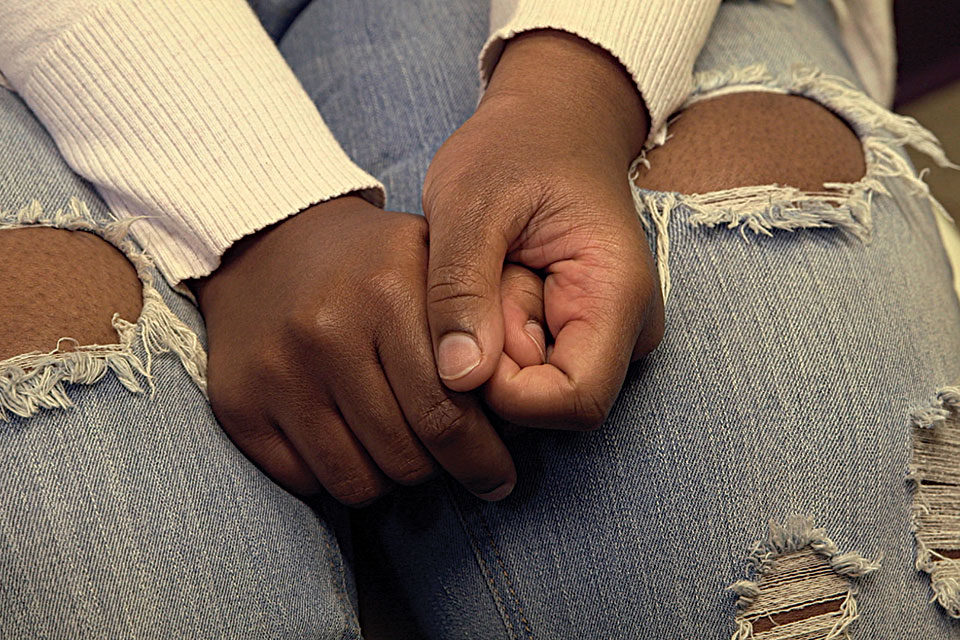
A recurring passage set in a hospital in Kano, Nigeria, initially creates harrowing human drama out of a baby’s delivery in an understaffed and clearly underfunded hospital. But the drama increasingly becomes tied to whether the person behind the camera will intervene in the child’s survival—and simultaneously whether the camera will run out of battery power. In Foca, Johnson films the day-to-day lives of a Muslim family who have returned home following the ethnic-cleansing horrors of the Bosnian War, but among the most memorable dramas we see is a mini-suspense scene in which the camera alights on two of the youngest children playing in the yard, a boy carelessly swinging an ax a few inches from his toddler brother’s face. We hear Johnson muttering with anxiety, then sighing with relief, but never leaving her post to emerge into frame. In Zalingei, Darfur, two women whose homes were stolen by Arab militants wryly ask the person behind the camera if she can help restore their houses. Knowing that she cannot, they turn away from the camera’s gaze to continue chopping down a tree.
Back in Johnson’s home country, questions around interference and objectivity are just as acute. In Huntsville, Alabama, an anonymous teenage patient awaiting a doctor at an abortion clinic, shown only in a static shot trained on her holey jeans, says she “feels like a bad person” for going through with the procedure; she is reassured by voices behind the camera that she should feel no guilt, before being coached where to start her sentence so they can better record it for the film. In a snippet from Washington D.C., Michael Moore is seen telling conscientious objector Corporal Abdul Henderson in front of the Capitol building that he’ll do everything he can to help with lawyer fees resulting from his refusal to return to Iraq (the film, Fahrenheit 9/11, is among the most recognizable clips). Even Johnson’s most deeply personal footage, featuring her Alzheimer’s-afflicted mother, raises queries about the consent of the person being filmed, and the nature of the relationship between subject and artist.
The key to Cameraperson’s triumph is that nothing in the film was created with the knowledge of being used for this purpose, which leaves the footage itself—shot for movies directed by the likes of Laura Poitras, Kirby Dick, Amir Bar-Lev, Gini Reticker, Moore, and many others—uncompromised by manipulation or intentionality. Yet Johnson is dedicated and philosophical in her conception of this film, and in her thinking of what the camera can be and do (the press notes come with Johnson’s “incomplete list of what the camera enables”—which is 23 items deep). If she had set out to shoot an original film on this subject, this could have been rigid, overthought, a self-regarding conceptual project. Instead, by pulling together preexisting content, taken out of its original context, she’s created a work of casual artistry, in which she has made the invisible visible, a kind of secret cinema that exists behind the one we normally take in, and take for granted.
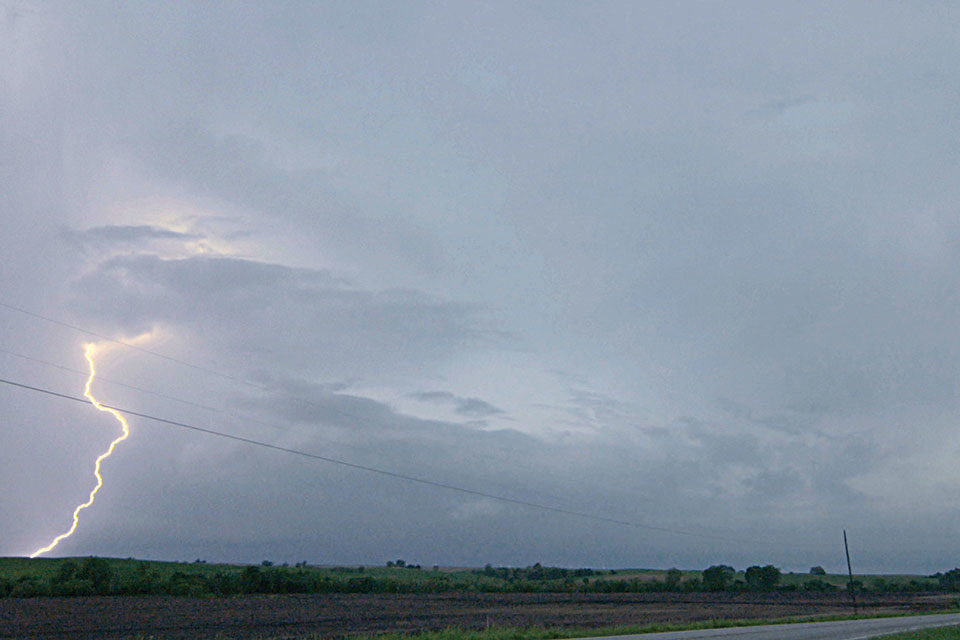
Once the snippets have been sewn together by Johnson’s editor, Nels Bangerter (who cut 2013’s remarkable Let the Fire Burn), disparate places are connected in ways both visual (the wind whistling through grass first in Wyoming, then in Foca) and thematic (we see a close-up of a letter Johnson wrote to God in 1975 from her Beaux Arts, Washington, home—“You are a great God!”—then a mosque prayer in Herat, Afghanistan,then young ballerinas dancing to Christian pop before a looming cross in Colorado Springs), and the footage sings anew. These tactics don’t convey some banal observation on the interconnectedness of our world but a revelation of the inner world of the film’s creator. Alongside Cameraperson’s provenance as a work of ethical interrogation is the expression of a woman whose perspective has been greatly affected by the things she’s seen. During one passage in Sarajevo, war photographers talk about their nightmares and post-traumatic stress. Johnson seems to align herself with them, but her film is too multifaceted to elicit pity or awe. Instead, she ties her own observations into a hushed contemplation of the world’s evils.
In the most extraordinary sequence, Johnson silently moves from a series of spaces, most in Foca, that still reverberate with the horrors of the Bosnian War—the police station that was a headquarters for ethnic cleansing, now inhabited by carefree kids playing ping-pong; the Partizan Sports Hall, where Muslim women were imprisoned and raped; the destroyed space of the Aladza Mosque; the rape and enslavement camp known as “Karaman’s House” (we may subliminally recall this house, now overgrown with wildflowers from Cameraperson’s very first shot); the Motel Miljevina, where Serb soldiers organized—to abandoned sites from around the world that speak to death and genocide. These include the pickup truck that dragged James Byrd Jr. to his death in Jasper, Texas; Wounded Knee; Tahrir Square, where more than 900 civilians have been killed since 2011; Nyamata Church in Rwanda, where 10,000 Tutsis were massacred; Ground Zero at the World Trade Center; Hotel Africa, an execution site of the Liberian Civil War; Guantanamo Bay’s Camp X-Ray; the Russian-built Bibi Mahru Hill Swimming Pool in Kabul, later used as for Taliban public executions. The film then brings us from the incomprehensible macro to the unimaginable micro: young Najibullah Afghan, a Kabul teen telling the story of losing an eye and his brother to a bomb blast. During it all, we are allowed to consider at once the lingering pain of war and violence, the ability of the camera to bear witness, and the simultaneous insufficiency of that ability to make sense of a tumultuous world. For Johnson, who, starting in 1997, cut her teeth shooting over 200 interviews with Holocaust survivors for the Shoah Foundation, this is hardly tangential to her experience of cinema.
Johnson doesn’t seem to want us to forget, however, that just as much as the camera creates spaces for contemplation, it also encourages performativity. In a sequence in Westport, New York, filmmaker Kathy Leichter, on screen in her own movie about her mother’s suicide, feels empowered to abandon discretion. Leichter begins to angrily throw around the detritus of her dead parent’s life, which had until this point been neatly stored in bags and cardboard filing boxes. “I’m sick of it!” she screams, making a mess of the bedroom, in the process becoming a compelling subject—an actor, in a sense—for the camera. Her emotional outburst gives way to an unplanned eruption: there’s a sound of rumbling, and the camera whips to the window, where we see a mini-avalanche of snow sliding from the roof and piling up in the backyard. “That was crazy!” Laughter erupts, cutting the tension. The women marvel at the moment, and that it was caught on video. Two spontaneous performances for the camera: one of feeling, one of nature; one coaxed, one captured by chance.
Closer Look: Cameraperson opens on September 9.



